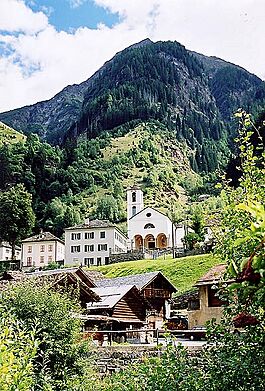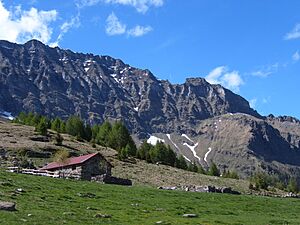Rossa, Switzerland facts for kids
Quick facts for kids
Rossa
|
||
|---|---|---|
 |
||
|
||
| Country | Switzerland | |
| Canton | Graubünden | |
| District | Moesa | |
| Area | ||
| • Total | 58.89 km2 (22.74 sq mi) | |
| Elevation | 1,089 m (3,573 ft) | |
| Population
(Dec 2020 )
|
||
| • Total | 151 | |
| • Density | 2.564/km2 (6.641/sq mi) | |
| Postal code |
6548
|
|
| Surrounded by | Malvaglia (TI), Biasca (TI), Mesocco, Soazza, Cauco | |
Rossa is a small town, also called a municipality, located in the Moesa Region in Switzerland. It's part of the canton of Graubünden. The main language spoken here is Italian.
Contents
A Look Back: Rossa's History
Rossa was first written about in official records way back in 1694. This is the earliest time we know it existed as a recognized place.
Rossa's Geography
Rossa covers an area of about 58.9 square kilometers (22.7 square miles). A small part of this land, about 9.1%, is used for farming. Forests cover a large portion, about 40.8% of the area.
Only a tiny bit, 0.4%, has buildings or roads. The rest, nearly half of Rossa's land (49.7%), is made up of natural features like rivers, glaciers, or mountains.
Location Changes Over Time
Before 2017, Rossa was part of the Calanca sub-district. After 2017, it became part of the Moesa Region. It is the highest town in the Val Calanca valley.
People of Rossa: Demographics
Rossa has a population of 151 people. About 10.7% of the people living in Rossa are from other countries. Over the last ten years, the number of people living in Rossa has gone down by about 14.4%.
Languages Spoken
Most people in Rossa speak Italian, which is about 84.1% of the population. German is the second most common language, spoken by 11.4% of residents. French is spoken by about 3.0% of the people.
Age and Gender in Rossa
In Rossa, the population is almost evenly split between males and females. About 50.4% are male and 49.6% are female.
Here's a look at the age groups:
- Children (0-9 years old): 3.8%
- Teenagers (10-19 years old): 6.0% (4.5% are 10-14, and 1.5% are 15-19)
- Young Adults (20-29 years old): 8.3%
- Adults (30-59 years old): 38.6% (6.8% are 30-39, 17.4% are 40-49, and 14.4% are 50-59)
- Seniors (60-99 years old): 43.2% (12.9% are 60-69, 16.7% are 70-79, 10.6% are 80-89, and 3.0% are 90-99)
Political Choices
In the 2007 federal election, the most popular political group was the Social Democratic Party (SP). They received 37.2% of the votes. The next two most popular groups were the Swiss People's Party (SVP) with 21.5% and the Free Democratic Party (FDP) with 20.2%.
Education and Work
About 69.3% of adults in Rossa (aged 25-64) have finished either high school or gone on to higher education, like a university.
Rossa has a low unemployment rate of 2.22%. This means most people who want to work can find jobs.
How People Make a Living
In 2005, people in Rossa worked in different types of jobs:
- Primary sector: This includes jobs like farming or forestry. There were 4 people working in this area, with 3 businesses.
- Secondary sector: This involves making things, like in factories. There were 6 people working here, with 2 businesses.
- Tertiary sector: This covers service jobs, like shops or tourism. There were 8 people working in this sector, with 4 businesses.
Population Changes Over Time
The table below shows how Rossa's population has changed through history:
| year | population |
|---|---|
| 1683 | c. 450 |
| 1773 | 331 |
| 1850 | 186 |
| 1900 | 181 |
| 1950 | 117 |
| 1980 | 109 |
| 1990 | 108 |
| 2000 | 132 |
See also
 In Spanish: Rossa (Grisones) para niños
In Spanish: Rossa (Grisones) para niños






